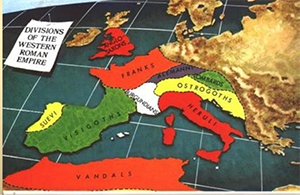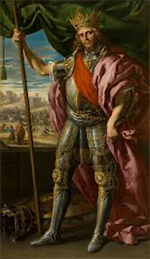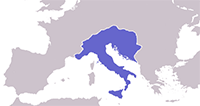The Ostrogoths
The Ostrogoths were the eastern tribes of the nomadic people known as Goths who played a part in the shifting sands of history in Europe for a few hundred years in the first millennium. 
The Goths are thought to have moved into territory neighboring the Roman Empire by the 3rd Century. The Ostrogoths settled in what is now Ukraine, on the northern shore of the Black Sea. They lived there for a time but then fell victim to the westward migration of the Huns, who set upon the various Germanic tribes in waves in the late 4th Century. The Visigoths migrated further west and came into sharp conflict with the Romans. The Ostrogoths remained where they were, at times fighting alongside the Huns, as at the famous defeat of Attila at the Battle of Chalons in 451. The Huns ruled the Ostrogoths until the death of the infamous Attila in 453. Then, the Ostrogoths allied themselves with another nearby people, the Gepids, and rose up against Attila's sons. Valamir, who had been a general under Attila, led the Ostrogoth force. At the Battle of Nedao in 454, the Gepid-Ostrogoth alliance was victorious, and the Ostrogoths found themselves free to settle in Pannonia and make an alliance with the Eastern Roman Empire, the Byzantines. Valamir ruled the Ostrogoths until 469. His son, Widimir, succeeded him and his son, Theodemir, succeeded him. That king's son was the most famous of the Ostrogothic kings. Theodoric the Great, who had served as hostage for a time at the Byzantine court in Constantinople, became leader of the Ostrogoths in the 470s. It wasn't long before the Byzantine emperor wanted Theodoric to go to war. Zeno wanted to regain Italy, which had fallen to Theodoric set about making alliances with neighbors, sending one of his daughters to marry King Alaric II of the Visigoths and himself marrying a sister of the Frankish king Clovis. When Alaric II died in battle in 507, Theodoric assumed the regency of Spain (on behalf of his daughter's and Alaric's son). 
Theodoric envisioned him as the latest in a long line of great rulers of what had been the Roman Empire. He tried to keep the peace in his newly declared kingdom by declaring religious tolerance for his subjects. With peace at hand, he engaged his soldiers and others in rebuilding cities and forests and otherwise repairing the damaged landscape. This created employment opportunities for many people. He applied laws and taxes equally to everyone who served him. He encouraged education and literacy across the kingdom. He even commissioned his chief scribe, Cassiodorus, to write the history of the Goths. Theodoric died in 526, and his young grandson, Athalric, became king. Theodoric's daughter Amalasuntha served as regent while appealing for the new Byzantine emperor, Justinian, for support. Her son died in 534, and she declared herself queen. When Amalasuntha was killed in 535, the victim of assassination by her cousin Theodahad, Justinian found an opportunity to invade Italy and sent his best general, Belisarius, to do it. The Byzantines defeated the Ostrogoths, then ruled by the ineffective Witigis, and took control of Italy. Justinian called Belisarius home in 541, and the Ostrogoths, under Totila, rebelled. They had initial success, seizing occupied cities and even taking Rome at one point. Another Byzantine army led by another general, Narses, came back and defeated the Ostrogoths once and for all, in 553. The victors allowed the defeated to continue to live where they were but without their own king, recognizing Byzantine sovereignty instead. The Ostrogoths had one more brief zenith of power, joining the Lombards in yet another conquest of Italy, in 568. That alliance marked the end of the Ostrogoths as an independent entity. |
|
Social Studies for Kids
copyright 2002–2025
David White



 Odoacer in 476. Theodoric led his army of Ostrogoths into Italy in 488 and succeeded in killing Odoacer five years later. The victors then solidified their gains and declared the Ostrogothic Kingdom of Italy, with headquarters in
Odoacer in 476. Theodoric led his army of Ostrogoths into Italy in 488 and succeeded in killing Odoacer five years later. The victors then solidified their gains and declared the Ostrogothic Kingdom of Italy, with headquarters in 
